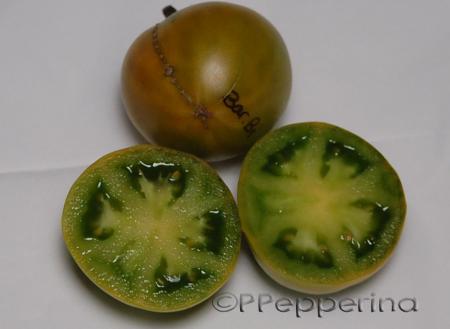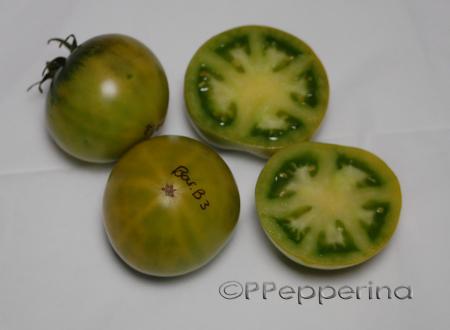

|
Forum area for discussing hybridizing tomatoes in technical terms and information pertinent to trait/variety specific long-term (1+ years) growout projects.
|
 |
|
|
Thread Tools | Display Modes |
|
|
#1 |
|
Crosstalk™ Forum Moderator
Join Date: Aug 2006
Location: 8407 18th Ave West 7-203 Everett, Washington 98204
Posts: 1,157
|
DSCN1196.JPG
The thumbnail above is a close up shot of Verde Claro type of tomato. Be sure to click on it. The rationale on showing this tomato fruit is somewhat complicated. A simple complexity, if you would.
So, the ontogeny of Verde Claro began with crossing the Green Grape tomato with as many pink skinned tomatoes as I could find in my collection or could buy seed of. Pink skinned tomatoes have a clear epidermis. So do white tomatoes, otherwise they would appear more yellow. Green Grapes, or as I use to call them, Thompson Seedless Green Grape tomatoes, have a yellow epidermis. The ripening of yellow epidermis on green fleshed tomatoes makes it easy to determine ripeness. The ripe fruits become more amber in tone. What would happen if I had a selection with a clear epidermis? Clear means claro in Spanish, and verde means green, and I anticipated a clear green fruit. See photo above. So the Hide and Seek began. Many F-1 hybrids were made. All of the hybrids had yellow epidermis traits. Some of the hybrids were quite nice in flavors, sweetness, and vigor. Many of the more flavorful F-2 lines were sown with the again renewed anticipations. In some cases bulked F-3 seed of sibs were saved, others single fruits. and not just green fleshed either. 32 plants were bulked of one group of green fleshed tomatoes out of a certain progeny and one selected vine the next year began my F-4 seed of a Verde Claro. It went through several more single seed descent increases in several locations in California. I have various levels of filial generations of the Verde Claro and even Carolyn has one from this pre-conceptualed group. However, I went back recently to this F-3 seed, especially those with yellow epidermis traits to see if I could segregate out a new version of Verde Claro. This is where the a priori juncture begins. Could I recreate the Verde Claro type from the genesis and for what purpose? Yes, and for the purpose of having a normal seed size version rather than the super small seed of a Verde Claro. Note the normal seed size. Later I will post a Verde Claro with the smaller seed. Sweet, tender, flavorful, and packed with a revelation of living sensation. The uses of such a tomato is like saying what is obvious, so I will use and choose cunning; I am going to start yelling that this one should be used as the female parent in some soon-to-be classic hybrids.
|
|
|

|
|
|
#2 |
|
Tomatovillian™
Join Date: Feb 2006
Location: Warm Springs, GA
Posts: 1,421
|
Tom I am going to come back and respond after some coffee
   Back from running errands. I am going to start paying more attention as I would love to learn as much as I can about crossing tomatoes. I wondered if you have ever used Russian Green for any crosses? I can't really add much to this forum as I am clueless of such but will continue to glean any info you feel like presenting Tom! Last edited by Rena; September 19, 2007 at 10:24 AM. |
|
|

|
|
|
#3 | |
|
Cross Hemisphere Dwarf Project™ Moderator
Join Date: Jan 2006
Location: New South Wales, Australia
Posts: 3,094
|
Quote:
Sounds great!  Patrina
__________________
Truth is colourful, not just black and white. PP: 2005 |
|
|
|

|
|
|
#4 | |
|
Crosstalk™ Forum Moderator
Join Date: Aug 2006
Location: 8407 18th Ave West 7-203 Everett, Washington 98204
Posts: 1,157
|
Patrina's words,
Quote:
|
|
|
|

|
|
|
#5 |
|
Tomatoville® Moderator
Join Date: Jan 2006
Location: Hendersonville, NC zone 7
Posts: 10,385
|
For me, Aunt Ruby's German Green, Green Giant, and a few of our developing dwarfs, such as Summertime Green and Dwarf Kelly Green, have clear skin. I think that the only tomato that is controversial on this is Aunt Ruby's since a few others see it as yellow skinned...but not in my garden!
__________________
Craig |
|
|

|
|
|
#6 | |
|
Moderator Emeritus
Join Date: Jan 2006
Location: Upstate NY, zone 4b/5a
Posts: 21,169
|
Quote:
Craig sent me and at least one other person his seeds from ARGG and I got the typical amber blush, as I did with Green Giant as well. Reinhard said that he Grew GG in a greenhouse where it was quite warm and got no blush, so there's that to consider as well. And I remember several folks who live in the southern areas who didn't get an amber blush on some green when ripes either. Texas comes to mind but I can't remember who it was. Verde Claro as grown by me has no blush and actually it has a very frosty look, almost like sugared grapes, which is quite different from other green when ripes that I've grown.
__________________
Carolyn |
|
|
|

|
|
|
#7 |
|
Tomatovillian™
Join Date: Jan 2006
Location: Saumarez Ponds, NSW, Australia
Posts: 946
|
Tom, what are the inheritance characteristics of seed size? I've never taken any notice of seed size and germination. Perhaps I should.
__________________
Ray |
|
|

|
|
|
#8 | |
|
Crosstalk™ Forum Moderator
Join Date: Aug 2006
Location: 8407 18th Ave West 7-203 Everett, Washington 98204
Posts: 1,157
|
Quote:
Seed size is definitely an inherited trait. I like small seed size because I link a whole bunch of traits with it. More on that whenever anybody wants to know. Reducing seed size too much leads of slower germination and seedling vigor, however the resulting seedling plants come out it when they can produce energy on their own and not have to rely on the storage within the seed. I try to achieve tiny seed size with near seedlessness, which is akin to heedlessness and needlessness to some folks. I have spent way too much time on this breeding effort, much to the chagrin of nearly everybody. Diverticulitis sufferers take note, however! I don't think I have gotten success on small seed size until I get germination rates down to about 10%!!!!  Tom Wagner |
|
|
|

|
|
|
#9 | |
|
Tomatovillian™
Join Date: Jan 2006
Location: Saumarez Ponds, NSW, Australia
Posts: 946
|
Quote:
__________________
Ray |
|
|
|

|
|
|
#10 |
|
Crosstalk™ Forum Moderator
Join Date: Aug 2006
Location: 8407 18th Ave West 7-203 Everett, Washington 98204
Posts: 1,157
|
Small seed size is a challenge to work with, but it's fun!
Some small/tiny seed varieties have uniform seed size. Others yet have a gradation of seed sizes that include diminished "specks" that may or may not germinate. Some day I will use more technical jargon as to the morphologies and physiologies. I feel that a rationale can be made for having varietal strains that are difficult to propagate. It keeps the variety rare, keeps it in the hands of the expert, and requires tremendous numbers of fruit to obtain seed sizes ample enough to save. The cleaning, screening, and testing for optimum seed size of these strains is like a work or art. Another option for tiny seed size is to cross them as pollen parents to huge seed size female parents to re-establish seedling vigor, but reduce the seed size of the hybrid. A lot of issues I haven't covered, but there is always another day for that! Tom Wagner |
|
|

|
|
|
#11 | |
|
Cross Hemisphere Dwarf Project™ Moderator
Join Date: Jan 2006
Location: New South Wales, Australia
Posts: 3,094
|
Quote:
  Maybe this happens to ARGG too. Patrina
__________________
Truth is colourful, not just black and white. PP: 2005 |
|
|
|

|
|
|
#12 |
|
Tomatovillian™
Join Date: Feb 2006
Location: Alabama
Posts: 2,250
|
I'll follow up on Tom's post re small seed size with a few observations from my garden.
Seed size is highly inherited and tends to be largest in beefsteak varieties and smallest in cherries. Examples of this are as close as Green Giant with very large seed, Brandywine with relatively large seed, Kimberly with medium sized seed, Galina with medium/small seed, and ILDI with very small seed. Ildi is so small it will readily go through ordinary screen wire when washed with water. I had to buy a fine screen strainer just to handle the seed without washing most of them down the drain. While there are several traits that contribute to seedlessness, I do not find that size of seed is directly correlated with seedlessness though certain small varieties produce very few seed and what they do produce are tiny. An example of this is Dwarf Besser which is a very small christmas tree shaped plant that rarely gets over 16 inches tall. It produces about 5 viable seed per fruit with entire clusters sometimes totally seedless. I do not object to fruit having some seed, but I don't like an excessively seedy fruit. German and Pink Ping Pong are varieties that produce so much seed per fruit that I prefer not to eat them. Male sterility is a trait I have seen only in one variety. That is the strain of Besser I was given by Brainsander about 5 years ago. The reason I found it in the first place was because the seed I saved were always hopelessly crossed. When I checked the flowers for pollen, I found that they produced very little but that the pistils were exposed and bees readily visited the flowers even in preference to other tomato varieties planted beside the Besser's. DarJones Last edited by Fusion_power; February 10, 2008 at 11:50 PM. |
|
|

|
 |
|
|
